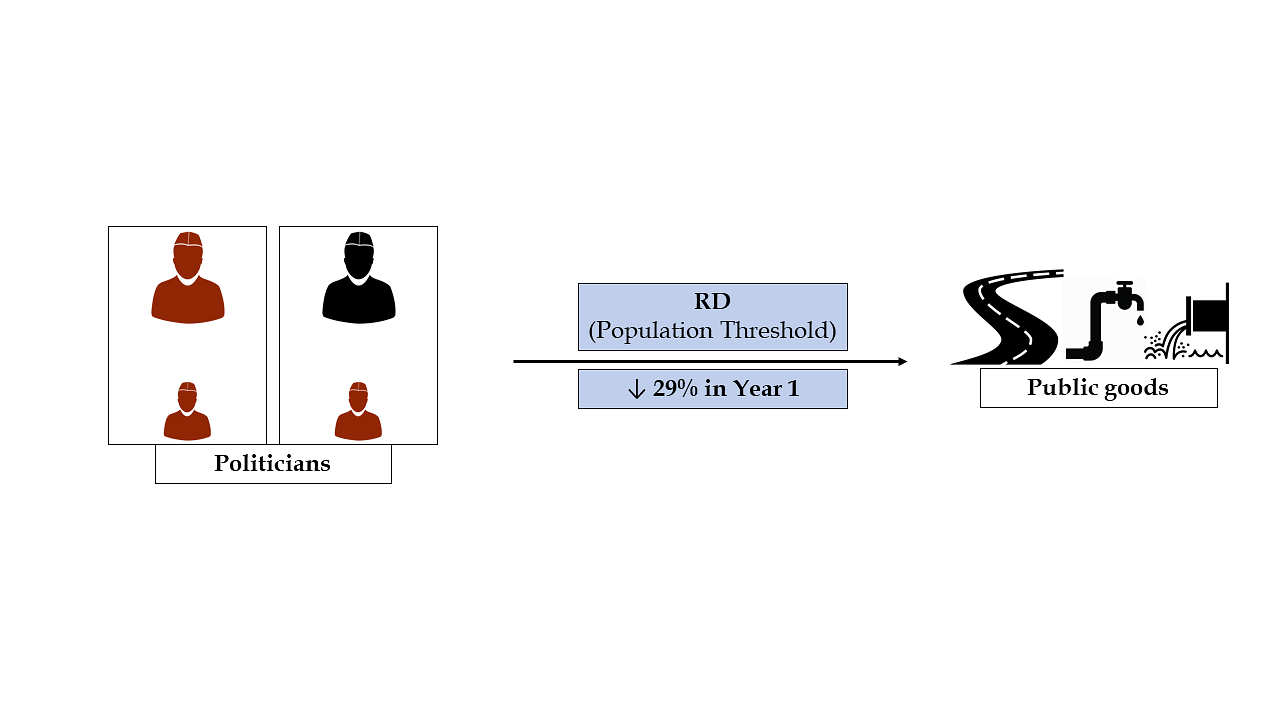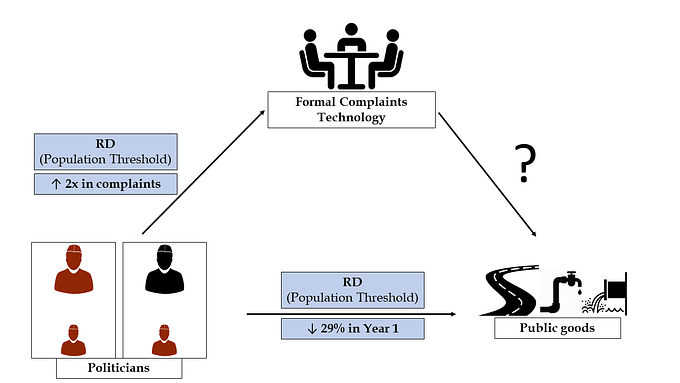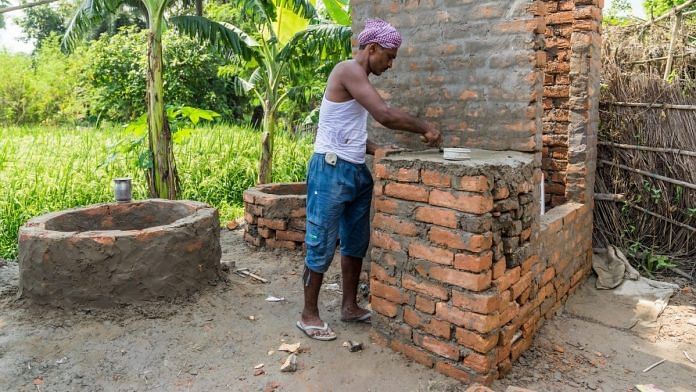Ethnic diversity adversely impacts public good provision, disproportionately affecting minority communities. While political representation could mitigate these effects, successful delivery of public goods often depends on how well minority and majority representatives collaborate. Using data from over 100,000 local politicians in India, we show that ethnic differences cause breakdowns in collaboration. We then show that a formal complaints technology can help minority members of government overcome these ethnic differences and effectively provide public goods to their constituents.
We set our study in the Indian state of Bihar, whose local administrative structure comprises over 8,400 gram panchayats (village councils), which are further divided into wards (13.6 wards every gram panchayat, on average). Both gram panchayats and wards are represented by elected politicians, referred to as “upper-tiered” (gram panchayat) and “lower-tiered” (ward) representatives. The ethnic differences we focus on are along caste lines and our main minority caste groups are ‘Scheduled Castes’ (SCs).

The overwhelming majority (over 80 per cent) of lower-tiered SC representatives govern under a non-SC upper-tiered representative.
We study a set of key water and sanitation (WAS) public goods – laying of drains and village roads; and piped water connection to households. These public goods are created under a government scheme that funds construction across all wards over a three year period (2017- 2020).
Also read: Delhi municipal councillors care more for performance ratings in newspapers: Study
Caste differences worsen public good provision
To understand how caste differences affect public good provision, we use a common econometric technique called the Regression Discontinuity (RD) design. In Bihar, gram panchayats are assigned an SC upper-tiered representative if the Scheduled Caste population of the gram panchayat crosses a particular number. An RD design involves comparing gram panchayats whose populations fall extremely close to that number, so that they look similar across most dimensions, but vary in whether or not the upper-tiered representative is from a Scheduled Caste background. This allows us to see what happens when Scheduled Caste lower-tiered representatives face caste differences.
Our first finding is that caste differences worsen public good provision in jurisdictions governed by lower-tiered SC representatives. In particular, projects in SC wards are delayed and face implementation related hurdles. We measure water and sanitation (WAS) outcomes using an administrative dataset of over 98,000 ward-level public goods constructed across Bihar during the first two years of the scheme being in place (March 2017 – March 2019). Caste differences cause 29 per cent fewer WAS projects in the first year for SC wards. While this gap reduces somewhat by the end of the second year, it remains large (27 per cent) and significant for those sub-castes among SCs who are at the bottom of the caste hierarchy.
Two additional pieces of evidence based on surveys of representatives in wards complement this finding. First, SC representatives with non-SC upper-tiered representatives report more obstacles* in implementation while undertaking WAS projects. They are 18 percentage points (41 per cent) likelier to name the upper-tiered representative as the main impediment to their effective functioning. Second, when projects are not undertaken, SC representatives are more likely to blame the upper-tiered representative for non-implementation. Reversing roles does not have the same effect: when the upper-tiered representative is SC, non-SC wards do not suffer. This indicates that ethnic differences exacerbate inequality, with disadvantaged caste groups being most likely to be denied public goods by non-minority group upper-tiered representatives.
Also read: Coping with climate change harder for marginalised women, says study
Formal complaints technology
A formal complaints technology has the potential to mitigate the adverse effects of caste differences. The Bihar Right to Public Grievance Redressal Act (BPGRA) was passed in 2016 and gave every citizen a right to resolution of a wide range of complaints – officially called “grievances” – against the local state in a time-bound manner. However, its penetration is low: only 25 per cent of lower-tiered Scheduled Caste representatives have heard of it and can answer basic questions about the formal complaints technology correctly; second, complaint filing is costly for most lower caste persons, since it chiefly involves making multiple trips to a distant complaint resolution centre.**

Our second finding is that caste differences cause lower-tiered SC representatives to file more complaints pertaining to WAS project implementation. While governing under non-SC representatives, lower-tiered SC representatives file twice as many complaints regarding WAS public goods.*** On the other hand, exactly in line with our project implementation results, lower-tiered non-SC representatives do not complain more under upper-tiered SC representatives. The asymmetric nature of these results strongly suggests the role of caste hierarchies in determining how divisions affect collaboration.
Also read: Indian democracy’s big contradiction – Dalits cherish Constitution, privileged want a rethink
Complaints effective, improve public good provision
Does filing complaints change incentives of upper-tiered representatives and improve WAS public good provision? We conduct a large field experiment — called a Randomised Controlled Trial (RCT) — across 1,629 lower-tiered jurisdictions from gram panchayats whose total population is nearly 15 million. We provide information regarding the formal complaints technology and offer to file complaints (online) regarding WAS project initiation on behalf of randomly selected lower-tiered SC representatives.
The formal complaints technology is extremely effective and significantly improves WAS public good provision. There exists significant demand for the formal complaints technology: official data on complaints shows an increase of 41 percentage points in complaints filed in treated wards in the post-intervention period. Our endline survey – conducted three to four months after complaints were filed – shows an additional 6 percentage points (24 per cent) increase in WAS projects being undertaken in treated wards. (This further rises to 11 percentage points, or 33 per cent, if we extend project initiation to include projects starting in the week of the survey).
Treated representatives are also more likely to report that the main problem preventing projects from being undertaken had been resolved. The effect sizes are sufficient to account for 60 per cent of the impact of caste differences in the first year and could potentially close whatever remains of the gap in the second year. Back-of-the-envelope calculations suggest that the intervention is highly cost-effective, costing 2.5 paise for every rupee’s worth of public goods provided.
The treatment has positive spillovers on complaint filing and increases project initiation in neighbouring jurisdictions. Our endline survey of 945 neighboring wards where projects had not been undertaken indicates an 8 percentage points (40 per cent) increase in project initiation for neighbours of treated wards when compared to neighbours of control wards. Only 2.5 percentage points of these representatives actually file complaints. The discrepancy between complaints filed and project initiation in neighbouring wards suggests that the mere threat of a formal complaints technology could cause project initiation.
What then are the barriers to greater adoption of the new complaints mechanism? We conduct a smaller experiment where we treat lower-tiered SC representatives with information only but do not offer to file complaints. Information alone improves complaint filing rates by 7 percentage points (much lower than the 41 percentage points increase caused by the filing assistance treatment above). This result suggests that the main constraint to complaint filing is not information and that adoption would increase significantly with some form of mediation, a reduction in transaction costs or improving beliefs in the efficacy of the state.
Also read: Only 4 out of 82 secretaries working in Modi govt are from SC/ST communities
Effects of caste differences on collaboration
We develop a simple theory of collaboration between politicians that is consistent with our main findings. The setup involves two players, an upper-tiered and a lower-tiered representative engaging over multiple stages. The objective is to collaborate and implement a project that generates a surplus. Collaboration involves committing to put in some initial sunk effort to set up the project. If both players commit, collaboration occurs and they bargain over and split the surplus.
Caste differences increase effort costs of collaboration of the upper-tiered non-SC representative. This is consistent with documented evidence of the significant negative stereotypes non-SCs have about the SCs, including the notion that SCs are “polluting” and “untouchable” (nearly 47 per cent of households in Bihar report practising some form of untouchability against SCs). In the absence of collaboration, a lower-tiered representative can choose to file a costly complaint that triggers collaboration with a non-zero probability and imposes sanctions on the upper-tiered representative.
This setup is sufficient to explain our main empirical findings: (i) caste differences reduce collaboration (by adding to initial effort costs) (ii) caste differences result in more complaints (iii) a formal complaints technology increases collaboration. The model predicts that this increase is the outcome of two mechanisms: first, a “threat” mechanism driven by the fact that non-collaboration could cause complaints; second, a ”direct” mechanism where a complaint is filed and the formal complaints technology rules against the upper-tiered representative, thus forcing the upper-tiered representative to collaborate.
Our findings are also of relevance to policymakers. Our results show that ethnic quotas could be particularly potent when they are applied across tiers of government, since collaboration with others plays a key role in project implementation. Among the various tools being designed to increase transparency and accountability in government, formal complaints technologies are increasing in prominence. For instance, over 200 American cities have designed portals where citizens can log in and file complaints. Our results are in favour of designing these technologies to provide avenues for complaints not merely by citizens but also by members of the local state. This may prove beneficial in highly decentralised settings, particularly for members of ethnic minority groups.
Notes:
* They are likelier to report that the project is actually incomplete, that there were significant delays in starting projects and that they had less control over where the project would happen.
** On average, the travel costs to file a complaint amount to 75 per cent of the minimum unskilled wage. One must add the opportunity cost of time to calculate the full costs of complaining. Anecdotally, low caste representatives say it takes an entire day to travel to the complaints’ centre and file a complaint. Complainants make multiple trips to the centre to attend three-person “hearings” involving the departmental bureaucrat responsible for providing the service, a Public Grievance Redressal Officer (a judge-like figure) and the complainant.
***They also file more complaints concerning local administrative problems and issues related to their wards.
M. R. Sharan is a PhD scholar in Public Policy at Harvard University.
Chinmaya Kumar is a PhD scholar at the University of Chicago.
This is an edited excerpt from M. R. Sharan’s job market paper “Something to Complain About: How Minority Representatives Overcome Ethnic Differences”.




So the same study without including caste rather put the office rank in same order & show if any different results come up -_- The problem with such studies in that they are inherently biased to pick & chose the test setting, method & conclusions to what the authors already believe, nothing new comes up instead only intensification along group identities happens. Want to deal with the problems then take into account the concerns of employer & employees to create policy recommendations which help deal with the workplace & work.
Propagandada news…. From the CIA funded left leaned media